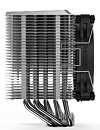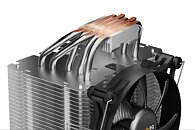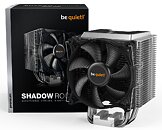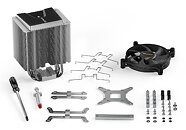Tuesday, February 18th 2020

be quiet! Announces Shadow Rock 3 CPU Cooler
be quiet!, the market leader in PC power supplies in Germany since 2007, announces Shadow Rock 3. This addition to the mid-range CPU cooler lineup of be quiet! features a redesigned heat sink and heat pipe layout and a Shadow Rock 2 fan to increase the rated cooling capacity to 190 W TDP while its asymmetrical design improves compatibility with tall RAM modules.
Compared to its predecessor, Shadow Rock 3 has undergone a substantial redesign. The previous model relied on four 8 mm heat pipes to cool the CPU, while Shadow Rock 3 now implements five 6 mm heat pipes with heat pipe direct touch (HDT) technology. The heat pipes are in direct contact with the processor surface, which results in fast heat transfer from the CPU to the heat sink. The fan has been upgraded to a Shadow Wings 2 120 mm PWM high-speed, which is decoupled from the heatsink and offers a silent operation at no higher than 24.4 dB(A), even at maximum speed. Users who are looking for even higher cooling performance have the option to attach a second fan to the heatsink.By making these structural changes, it became possible to reduce the number of fins from 51 to 30, which cut the weight of the cooler in half compared to its predecessor (716 vs 1120 grams). This significantly reduces the vertical stress placed on motherboards. The higher fin pitch in combination with an optimized fan raises the cooling performance of Shadow Rock 3 to 190 W TDP, enough to enable trouble-free overclocking of mainstream desktop processors.Asymmetrical design and top mounting system
In contrast to Shadow Rock 2, where the heatsink is placed centered above the base plate, Shadow Rock 3 uses an asymmetrical design, which moves the heatsink back towards the exhaust of the case for unobstructed access to the memory slots in front of the heatsink. This guarantees maximum compatibility with high-performance memory modules, including RAM with tall heat spreaders or LED lighting.
be quiet! does not just place emphasis on performance, but also on build quality, appearance, and ease-of-use. Installation is simplified thanks to a top mount design with included screwdriver. The top cover of Shadow Rock 3 is made from brushed aluminium and features a bi-color surface treatment for a unique visual design. The cooler is compatible with all current CPU sockets from Intel and AMD (except TR4 and sTRX4) and fits best on motherboards for mainstream processors with up to four memory slots.
Pricing and availability
Shadow Rock 3 will be available for sale on March 3rd at a recommended retail price of $49.90 / €49.90 / £45.99.
Compared to its predecessor, Shadow Rock 3 has undergone a substantial redesign. The previous model relied on four 8 mm heat pipes to cool the CPU, while Shadow Rock 3 now implements five 6 mm heat pipes with heat pipe direct touch (HDT) technology. The heat pipes are in direct contact with the processor surface, which results in fast heat transfer from the CPU to the heat sink. The fan has been upgraded to a Shadow Wings 2 120 mm PWM high-speed, which is decoupled from the heatsink and offers a silent operation at no higher than 24.4 dB(A), even at maximum speed. Users who are looking for even higher cooling performance have the option to attach a second fan to the heatsink.By making these structural changes, it became possible to reduce the number of fins from 51 to 30, which cut the weight of the cooler in half compared to its predecessor (716 vs 1120 grams). This significantly reduces the vertical stress placed on motherboards. The higher fin pitch in combination with an optimized fan raises the cooling performance of Shadow Rock 3 to 190 W TDP, enough to enable trouble-free overclocking of mainstream desktop processors.Asymmetrical design and top mounting system
In contrast to Shadow Rock 2, where the heatsink is placed centered above the base plate, Shadow Rock 3 uses an asymmetrical design, which moves the heatsink back towards the exhaust of the case for unobstructed access to the memory slots in front of the heatsink. This guarantees maximum compatibility with high-performance memory modules, including RAM with tall heat spreaders or LED lighting.
be quiet! does not just place emphasis on performance, but also on build quality, appearance, and ease-of-use. Installation is simplified thanks to a top mount design with included screwdriver. The top cover of Shadow Rock 3 is made from brushed aluminium and features a bi-color surface treatment for a unique visual design. The cooler is compatible with all current CPU sockets from Intel and AMD (except TR4 and sTRX4) and fits best on motherboards for mainstream processors with up to four memory slots.
Pricing and availability
Shadow Rock 3 will be available for sale on March 3rd at a recommended retail price of $49.90 / €49.90 / £45.99.







11 Comments on be quiet! Announces Shadow Rock 3 CPU Cooler
y/a/w/n
But hey, at least it's reasonably priced :D
I'm looking forward to the next generation 140mm based ones from Noctua, expected in 2021.
Edit: fixed typo
Would be interested in seeing a review of this though.